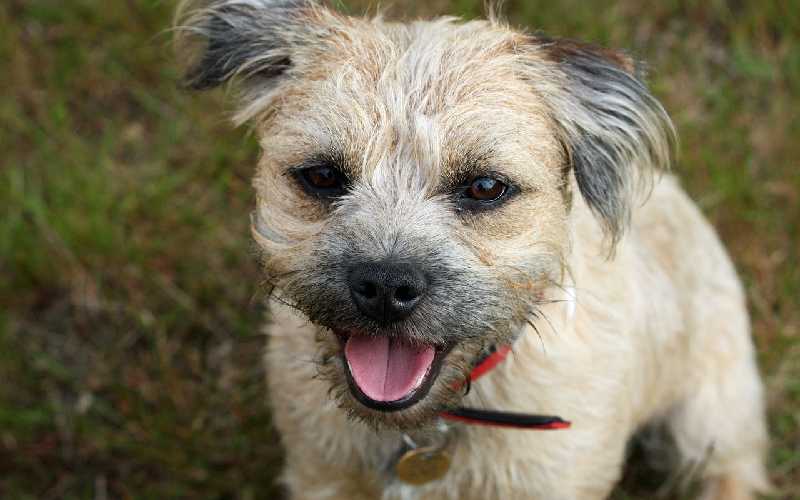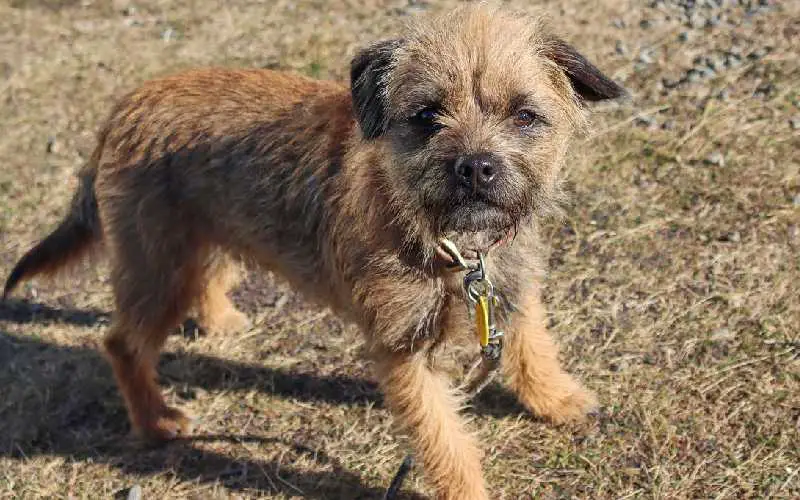The Border Terrier is a working terrier of Scotch origin, developed in the Anglo-Scottish border country. The term “border” refers to both the geographic area and its inhabitants (the Scottish Borders). It is a rough-coated breed with a wedge-shaped head, powerful jaws and a tail that curls over the back or side. They are energetic with an amiable disposition and willing to please. The Border Terrier is smaller than the Cairn, Dandie Dinmont or Fox terriers, but has a sturdier build. Its coat may be of any colour, less frequently seen in blue.
How the Border Terrier was Bred
The breed was created by crossing various types of terriers, likely including fox terriers (though the black and tan variety was specifically bred out), Dandie Dinmonts , Skye terriers, Tweed water spaniels and possibly the now extinct Southern Hound . The Border Terrrier is also believed to be closely related to the Dandie Dinmont. After the creation of the Border Terrier, later interbreeding with Dandie Dinmonts and other breeds was continued to refine the breed. The dogs were primarily working farm dogs in families that farmed large estates on both sides of the Scottish/English border where they worked as vermin exterminators.
Border Terrier Coat
The breed has a harsh, wiry coat that is weather resistant and water repellent. The coat may be of any colour, less frequently seen in blue or liver. They are well suited to an outdoor life in all kinds of weather conditions including extreme cold, heat and snow.
Despite their compact size and short coat, they are surprisingly heavy shedders: many owners do not have to brush the entire dog but only around its neck once per week to keep up with the hair fall. You might want to read: is the Border Terrier Hypoallergenic?

Healthy and Robust
The breed is healthy, robust, and very hardy. The Border terrier is an all-around dog that has proven its worth through many generations of devoted and faithful companions. Proof of this can be found in the number of awards for working trials. Their tendency to bark, however, makes them less desirable in a noisy environment i.e. a city apartment.
Good Pets and Farm Dogs
Border terriers can make good family dogs and children’s companions. They get along well with other pets if properly socialized.
A true “farm dog” from its breeding, it is loyal to the farmer that nourished it, but otherwise reserved around strangers. Even though they are more companionable than many other terriers, their tendency to bark will make them less desirable in a noisy environment.
Strong Prey Drive
Driven by their instinct to chase, they can be easily distracted from their task or will drive themselves mad trying to catch something that is gone. A Border will hunt anything from squirrels to cars and many things in between, so care must be taken when leaving this breed unsupervised. They are also known to dig, and will do so in the interests of catching prey.
The Border Terrier is a powerful dog with a broad head and a strong jaw for gripping game. They are vermin exterminators who have a relentless prey instinct.
Intelligent and Quick to Learn
The breed is intelligent and can learn quickly. They respond well to training that is handled without anger or harshness. Their desire to hunt makes them a good choice for dog sports such as agility or other canine events where their vermin chasing instincts are put to use.
Life Span of the Border Terrier
According to the American Kennel Club, the purebred Border Terrier has an average life span of 12–14 years, with similar statistics being reported by the UK Kennel Club. Both registries report no major health concerns, other than those that may affect all purebred dogs. The Border Terrier is a very healthy breed with no major medical issues reported from either registry or life-expectancy averages.
Kennel Club Recognised
The Border Terrier was first recognized by The Kennel Club in 1909. The breed shares its origins with the Dandie Dinmont terrier, but it has been developed as an improved working terrier. It is now recognised internationally; it was admitted into the American Kennel Club as a member of the Terrier Group in 1930 and has been in the AKC’s companion-dog classification since 1974.
Popular Terrier Breed
In April 2011, Dogs in Canada magazine ranked the Border Terrier first of all breeds on its list of “The Top 10 Most Popular Purebreds”. It was followed by a Jack Russell Terrier and a Yorkshire Terrier. In 2010, the “Border terrier” was the fourth of all breeds in registered dogs in the UK, while it was seventh in 2011.
If you enjoyed this article you might also like to read about:

